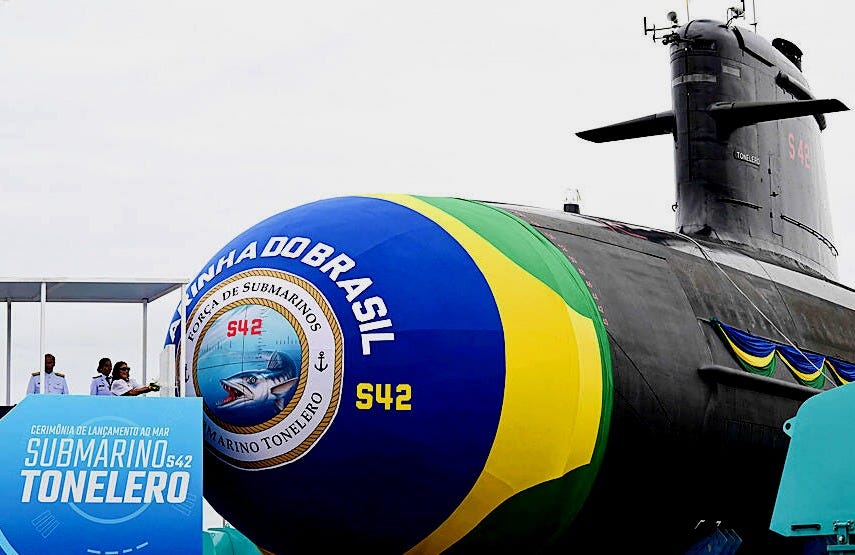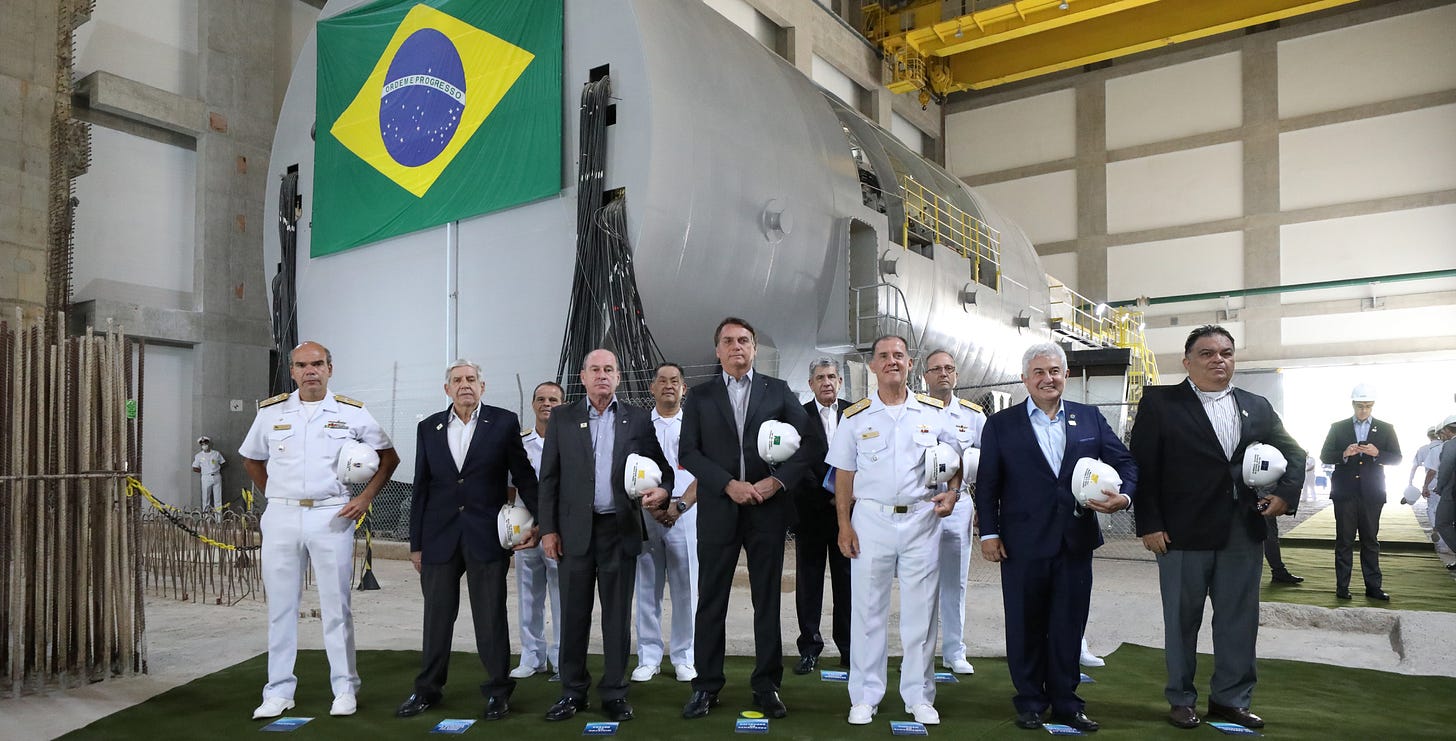S. Korea’s Nuclear Submarine Program May Have More in Common with Brazil than AUKUS
Brazil and South Korea are proving that advanced democracies can develop nuclear submarines while maintaining full NPT compliance, thereby establishing a replicable playbook for others to follow

This is the fifth installment in a continuing series on South Korea’s nuclear submarine program. Together, these articles chronicle how a once-controversial initiative has become one of East Asia’s most consequential naval procurement decisions. To access the other articles, please visit the Polemos Insights landing page.
When the United States (US) finally gave its blessing to South Korea’s nuclear submarine program, commentators immediately reached for the AUKUS comparison. On the surface, it made sense: two US allies in the Indo-Pacific working with Washington to acquire nuclear-powered attack submarines. The symmetry was too tempting to ignore.
However, such framing misses the real story. South Korea’s path looks far less like Australia’s AUKUS partnership and far more like Brazil’s quietly persistent nuclear submarine program, a national project launched over 40 years ago that has methodically advanced toward fielding a domestically built submarine powered by low enriched uranium (LEU), all the while adhering to international regulations on nonproliferation.
Seen together, the Brazilian and South Korean cases suggest something larger taking shape. What was once the guarded domain of nuclear-armed powers is becoming technically and politically accessible to others outside of this exclusive club.
Brazil has yet to launch its first nuclear-powered submarine, so definitive conclusions must wait. That said, its experience already provides compelling proof that a non–nuclear weapon state can move toward deploying a nuclear-powered fleet while remaining in lock step with nonproliferation regimes. In that sense, the Brazilian program — not so much AUKUS — closely mirrors the path South Korea is pursuing.
The Brazilian Precedent No One’s Really Watching
Brazil’s nuclear submarine ambitions date back to 1979, when the military government established the Nuclear Marine Program (PNM) to master the nuclear fuel cycle and develop naval propulsion. Following decades of intermittent progress hampered by budget constraints and political changes, the program gained decisive momentum in October 2023, when the first steel plate was cut for the lead nuclear boat at the Itaguaí Naval Complex.
Brazil’s drive to build nuclear submarines stems from its Blue Amazon, a 3.6 million-square-kilometer exclusive economic zone roughly equivalent in size to the Amazon rainforest and rich in energy resources. With vast offshore oil and gas reserves discovered in recent decades, policymakers view nuclear submarines as essential for protecting the nation’s maritime resources and securing its 7,400-kilometer (4,600-mile) coastline.
In order to acquire relevant expertise, Brazil turned to a foreign partner. In 2008, it formed a submarine industrial partnership with France and Naval Group (formerly DCNS). Through this partnership, Brazil gradually established a submarine construction infrastructure in Itaguaí. Brazil also received technical support and training for submarine hull design and construction. Of note, the agreement stipulated that France would be excluded entirely from any nuclear-related work, including reactor development.
In 2024, this arrangement was reaffirmed in the France–Brazil Strategic Partnership Action Plan, confirming both nations’ intent to cooperate at a high level “to complete the conventional submarines and develop the non-nuclear part of the Brazilian nuclear-powered submarine project.”
Meanwhile, the International Atomic Energy Agency (IAEA) has engaged with Brazil’s program since 2022, negotiating special safeguards procedures that appear to be unresolved as of November 2025. Key sticking points include Brazil’s refusal to sign the Additional Protocol, restricted centrifuge access, and the challenge of establishing unprecedented verification measures for LEU submarine fuel under the Nuclear Non-Proliferation Treaty (NPT).
Despite such differences, the IAEA and Brazil are known to be maintaining a constructive relationship. Brazil has shared updated design information for the LABGENE reactor and allowed IAEA design-verification inspections in September 2024. Technical consultations continue as both sides work toward a final safeguards framework.
Paving a Conventional Path to a Nuclear Solution
The comparisons between Brazil and South Korea reveal important similarities that transcend geography or alliance structure. Both countries are pursuing nuclear-powered submarines as non-nuclear weapon states under the NPT, following similar paths toward mastering reactor technology, expanding domestic shipbuilding capacity, and satisfying international oversight.
Each has prioritized developing an indigenous reactor fueled with LEU rather than weapons-grade HEU. Brazil’s pressurized-water reactor is being developed and fueled domestically under IAEA and Brazilian-Argentine Agency for Accounting and Control of Nuclear Materials (ABACC) safeguards. Meanwhile, South Korea’s reactor design reportedly draws on decades of research feeding into its ongoing small modular reactor (SMR) development. Much of the SMR work was recently consolidated under the Munmu Advanced Research Institute for Nuclear Science (MARINS).
Brasilia and Seoul’s LEU-based approaches reduce proliferation risk and political friction, demonstrating that effective naval propulsion can coexist with nonproliferation commitments. This stands in contrast to AUKUS, which will rely on HEU-powered reactors built abroad for Australian submarines.
Meanwhile, when it comes to shipbuilding, neither country is starting from scratch. With French technology transfer and training, Brazil has already built four conventional Scorpène-variant submarines at the Itaguaí Naval Complex, where the lead nuclear boat is currently under construction. As for South Korea, it has far greater expertise in submarine construction as demonstrated by the KSS-1 (Type 209), KSS-2 (Type 214), and KSS-3 programs, while the KSS-3 also showcased the country’s submarine design capabilities.
The Normalization Question
The Brazil-South Korea parallel reveals something larger than two isolated programs: nuclear propulsion may be normalizing for advanced industrial democracies. Until recently, only the five permanent members of the UN Security Council plus India, all six of whom are nuclear-armed, operated nuclear submarines. That exclusive club is about to break open. Brazil will likely commission the first nuclear submarine by a non-nuclear weapon state, followed by South Korea and Australia.
This normalization doesn’t represent nuclear weapons proliferation, as both Brazil and South Korea explicitly commit to non-nuclear weapon status and LEU fuel that minimize proliferation risks. Rather, the similar paths taken by Brasilia and Seoul reflect how naval technology that was once monopolized by superpowers is diffusing to regional powers with legitimate security needs and nonproliferation credentials. Furthermore, the commercial shipping industry’s adoption of SMR technology may ultimately dwarf military applications, further normalizing nuclear propulsion.
If Brazil and South Korea succeed, who’s next?
Japan possesses overwhelming technical capability and, like South Korea, faces threats from China and North Korea. Other middle powers, such as Poland, Indonesia, and Turkey, may eventually find interest. As SMR technology matures and LEU fuel cycles gain acceptance, the technical and political barriers will continue to fall. In turn, the question may no longer be whether more countries will pursue nuclear submarines, but how quickly - and whether the international community can establish robust safeguards frameworks before the next wave begins.


